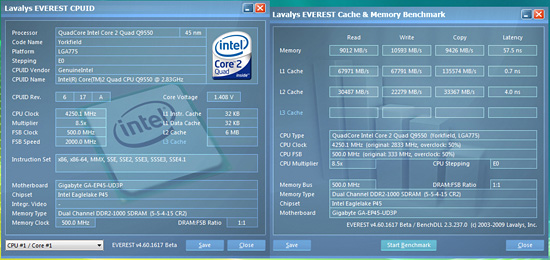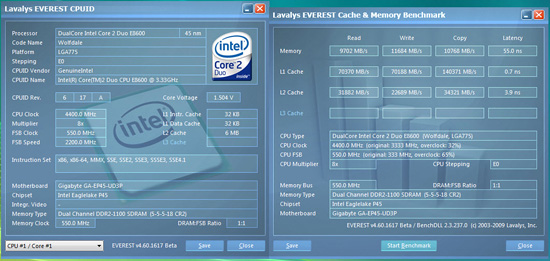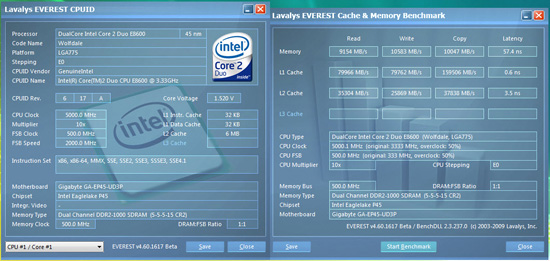Gigabyte GA-EP45-UD3P - P45 at its Finest
by Gary Key on February 3, 2009 12:15 AM EST- Posted in
- Motherboards
Overclocking
GIGABYTE advertises the GA-EP45-UD3P as a mainstream motherboard and will nudge users towards their enthusiast-oriented EP45 Extreme series or X48 boards for overclocking duties. We are here to say that is a big mistake based upon our results. We expected solid overclocking based on the BIOS design and board components, but this board clocked just as well or better than any upper-end P45 or X48 boards we have in the labs.
True, there are boards that might hit higher FSB rates or offer better memory performance, but we are concentrating on mainstream overclocking abilities in our tests. We focus on the type of overclocks that support 24/7 operation with reasonable cooling and the ability to run a multitude of programs without a problem. We are not optimizing for SuperPI or 3DMark records; it's more like trying to keep our bank records safe from a crash (sadly, there's nothing we can do about banks crashing).
We put an emphasis on stability during our testing sessions so we test with real world applications ranging from a variety of games to digital imaging software to various audio/video creation programs, along with the normal OCCT and PCMark Vantage tests.
Q9550 4GB Results

Our maximum overclock on air-cooling with the Q9550 resulted in a 4.25GHz clock speed at a respectable 500MHz FSB with our 4GB G.Skill memory kit set to DDR2-1000 at 5-5-4-15 timings. The primary voltages settings were 1.36V NB, 1.38V VTT, 1.70V PLL, 2.00V VDimm, and 1.425V for the CPU. We tried to run the memory higher, but could not get stability at the DDR2-1200 mark in Nero Recode or Crysis. Vdroop was approximately -.02V with Load Line Calibration (LLC) enabled and -.035V with it disabled at idle. Under load Vdroop was -.025V with LLC enabled and -.05V with it disabled.
Q9550 8GB Results

We were able to reach the same 8.5x500 for a 4.25GHz clock speed with 8GB at DDR2-1000 with 5-5-5-15 timings. However, our voltage settings changed to 1.38V NB, 1.40V VTT, 1.70V PLL, 2.06V VDimm, and 1.450V for the CPU to compensate for the additional load on the MCH. Under load Vdroop was -.02V with LLC enabled and -.05V with it disabled.
E8600 Results

Our maximum overclock on air-cooling with the E8600 came with a blistering 4.40GHz clock speed at a fully stable 550MHz FSB rate. Our 4GB G.Skill memory kit allowed us to reach DDR2-1100 at 5-5-5-18 settings. We used the following voltage settings: 1.40V NB, 1.36V VTT, 1.72V PLL, 2.08V VDimm, and 1.500V for the CPU. We had to drop to 8x500 to get 8GB stable while keeping VDimm below 2.1V, PLL below 1.80V, and NB below 1.50V. Vdroop was approximately -.01V with Load Line Calibration (LLC) enabled and -.025V with it disabled at idle. Under load Vdroop was -.02V with LLC enabled and -.04V with it disabled.
E8600 Additional Results

We knew we had a good E8600, so we pulled out our CoolIT Systems Freezone Elite kit and decided to see how far we could get on this board. We ended up at 5GHz with a 10x CPU multiplier and FSB set to 500. We installed 8GB of memory and ran it at DDR2-1000 with 5-5-5-15 timings. We used the following voltage settings: 1.42V NB, 1.40V VTT, 1.76V PLL, 2.04V VDimm, and 1.5675V (1.550V was stable after raising NB to 1.46V) for the CPU. This is the first time we have reached a stable 5GHz with this processor in a P45 board. Vdroop was similar to our results above.
Thoughts
We have absolutely no concerns about recommending this board for 24/7 500FSB+ use. This board overclocks quad-core chips just as easily as it does dual-core offerings, which is a feat that most P45 boards cannot accomplish. Depending on your processor choice, the Northbridge (MCH) and PLL voltages are two prime settings open for reduction. We only utilize retail processors so it is up to luck if we get a good processor or not for overclocking.
We ultimately ran our E8600 at 585FSB stable in all our applications except for Adobe Premier Pro 4.0; it would constantly hang at any FSB setting above 550. We also tried to verify GIGABYTE’s claim of DDR2-1366 support but our 2GB DDR2-1250 memory kit was unable to get above 1300. However, this is the first board that ran it stable at 1300 so we think it is just a limitation of our memory kit - or reluctance to push more than 2.4V into it.
In regards to voltage regulation, we think the GA-EP45-UD3P has excellent voltage output. We checked all the major voltages with a DMM and found very little variance between what you select in the BIOS and what the board actually outputs. The VTT, PLL, DIMM, and other voltages are accurate and stable across the spectrum. They show no real variances between idle and load states; if anything, we would see a small +.005V rise at times. As discussed, there is line droop on VCore when switching from idle to load situations. However, we found it was not substantial enough to affect stability or overclocking capabilities.
















73 Comments
View All Comments
Glenn - Tuesday, February 3, 2009 - link
On second reading of your original post I wonder if you need to "initialize" that disk within Administrator Tools/computer management/Disk Management ? If it's showing up in device manager that is likely the problem. The cables provided by gigabyte work in any motherboard slot to any internal sata device (HD or Optical Drive) in either orientation.7Enigma - Tuesday, February 3, 2009 - link
You solved my problem! I am now in the process of formatting the drive after initializing. I have NEVER had this issue before as I guess this issue is Vista specific.I cannot thank you enough. I wish this article (and hence my question) had been up a couple days ago and saved me the several hours of wasted life. :(
Now anyone have a good (free?) ghosting program that will allow me to clone my current 80gig drive to the 250gig so I can get rid of the old PATA to use in my old computer build?
semo - Tuesday, February 3, 2009 - link
you've probably never had this problem because your drive already came with an os or the first thing you've done with a new hard drive is to install an os on it. either case, the initialization was done for you.to mirror a hard disk --> http://www.pcinspector.de/Sites/clone_maxx/info.ht...">http://www.pcinspector.de/Sites/clone_maxx/info.ht...
to take a snapshot --> http://ping.windowsdream.com/">http://ping.windowsdream.com/
http://clonezilla.org/">http://clonezilla.org/
get the source and destination right. you only get one chance!
7Enigma - Wednesday, February 4, 2009 - link
I've never directly swapped drives out like I'm trying to do here, but I have added additional drives before (all old IDE) and other than the Master/Slave issue the drives were always recognized upon reboot (with a drive letter already given). I'm sure this Vista method gives more flexibility (can have multiple drives installed but not actually recognized), but it was new and annoying to me.As for the ghost program I think I'm going to use HDclone. While the free version has slow copy times (~1gig/min), I only have an 80gig HD I'm cloning from so I don't mind a bit extra time. And according to their website they claim they now support the extra space when cloning (previously all the freeware ghost programs had the annoying habit of not adding in the rest of the space on the new HD and so you were left with creating another partition, or getting a program like partition magic to do the job the ghost program should have in the first place.
Once again than you very much for all the help and quick advice!
I'll be interested to compare boot times of Vista and games with the new drive. My current 80gig is a 7200rpm Maxtor from several years ago and while the new drive is the same spindle speed I'm assuming that the higher density will allow for quite a bit of an improvement. I'm sitting on the sideline for another year or so before jumping on the SSD bandwagon. Too rich for my blood at the moment, but I drool over them.
strikeback03 - Wednesday, February 4, 2009 - link
In XP when adding SATA drives IIRC it was normal to have to format the drive before it could be used. I don't remember initialization being a separate step though, just format the unformatted space and it would work.7Enigma - Wednesday, February 4, 2009 - link
Just wanted to say I am no running my system on my new Seagate Barracuda 7200.10 ST3250410AS 250GB 7200 RPM 16MB Cache SATA 3.0Gb/s Hard Drive, after a 2hour HDclone that worked flawlessly (and free). Not only that but the new/current version of HDclone also expanded the partition for the new larger drive so I literally just unplugged the old drive after the clone and Vista isn't even complaining to validate again (a fear I had since my copy is Vista Home Premium OEM). I didn't want to try to explain why after building my system 2 weeks ago I'm already swapping the HD....Thanks again!
7Enigma - Wednesday, February 4, 2009 - link
no = *now*7Enigma - Tuesday, February 3, 2009 - link
That sounds exactly like something that may be the culprit. As I mentioned I just made the big switch from XP to Vista, and am not used to some of the Vista policies.I thank you very much for the advice and I'll have to try this ASAP!
7Enigma - Tuesday, February 3, 2009 - link
The bios is pretty confusing when it comes to this (and the manual also doesn't help). I have made sure the SATA bios settings are NOT set to AHCI or Raid, I believe the "off" setting is for it to be seen as IDE.I kinda figured SATA didn't use the Master/Slave, but my concern is that since my primary OS drive IS a PATA drive, that there is an issue with trying to recognize a Master SATA (it shows up as master in the bios, whatever that means).
Another thing is since trying to install the SATA drive (I've since taken it out until I can find some answers) right before Vista loads the windows icon and the logon screen my HD now makes a 5-6 second grinding noise like it's searching the entire drive or something. This never happened before trying to get the SATA drive hooked up, and while it doesn't seem to have affected performance once in windows, it is a bit annoying during bootup (I keep my system off most of the time so on average boot up 2-3 times per day).
The0ne - Tuesday, February 10, 2009 - link
I'm not entirely sure of this myself not having gone through reliable tests but I've been having similar problems with HD's as of late.Make sure you only have one primary HD. If you have multiple HD set as primary, doesn't have to be active, you will run in problems. Vista chokes up as well. Make sure your HD's are labled properly when partition, Simple, Basic, Primary, etc. And then there's the odd external drive like my WorldBook 1TB that, if connected and power on, will 100% prevent XP or Vista to load up fully to the desktop (on my IP35E MB) or 100% crashes and resets the BIOS when XP/Vista tries to load (currently my EP45-DS3R MB). This WorldBook can only be connected once you're on the desktop.
I have a hate relationship with WD external drives, they just want to die in my arms for no apparent reasons.